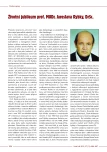Adherence to the international guidelines on the treatment of diabetic leg syndrome – options available in the Czech Republic
Authors:
A. Jirkovská
Authors‘ workplace:
Centrum diabetologie IKEM Praha, přednostka prof. MUDr. Terezie Pelikánová, DrSc.
Published in:
Vnitř Lék 2011; 57(11): 908-912
Category:
Birthday
Overview
Possibilities of fulfilling of the practical guidelines on the management of the diabetic foot in the Czech Republic are limited by lack of experts and specialized place of work in podiatry, inconsiderable are economic problems, too. Foot care is of highest quality when is directed by a multidisciplinary foot team. In the Czech Republic, there is an urgent need for podiatry training programme and foot clinic support. Investing in diabetic foot programme can be one of the most cost-effective forms of healthcare expenditure, provided the programme is goal-focused and properly implemented. Paper deal with key points of the podiatry programme – organization, health care education and effective prevention and risk patients follow-up, rational surgical treatment and foot infection management, extension of up – to date methods of PAD treatment, and effective economic approach to foot care especially considering DRG system during hospitalization.
Key words:
diabetic foot disease – therapy – foot clinic
Sources
1. International Working Group on the Diabetic Foot. International Consensus on the Diabetic Foot & Practical Guidelines on the Management and Prevention of the Diabetic Foot 2011, The Nedherlands 2011.
2. Mezinárodní pracovní skupina pro syndrom diabetické nohy. Syndrom diabetické nohy. Mezinárodní konsenzus. České vydání: A. Jirkovská (ed.). Praha: Galén 2000.
3. Valk GD, Kriegsman DM, Assendelft WJ. Patient education for preventing diabetic foot ulceration. A systematic review. Endocrinol Metab Clin North Am 2002; 3: 633–658.
4. Matricali GA, Dereymaeker G, Muls EG et al. Economic aspects of diabetic foot care in multidisciplinary setting: a review. Diabetes Metab Res Rev 2007; 23: 339–347.
5. Bevilacqua NJ, Rogers LC, Armstrong DG. Diabetic foot surgery: classifying patients to predict complications. Diabetes Metab Res Rev 2008; 24 (Suppl 1): S81–S83.
6. Lipsky BA, Armstrong DG, Citron DM et al. Ertapenem versus piperacillin/tazobactam for diabetic foot infections (SIDESTEP): prospective, randomised, controlled, double-blinded, multicentre trial. Lancet 2005; 366: 1695–1703.
7. Rao N, Ziran B, Lipsky BA. Treating Osteomyelitis: Antibiotics and Surgery. Plast Reconstr Surg 2011; 127 (Suppl 1): 177S–187S.
8. Fejfarová V, Jirkovská A, Skibová J et al. Vliv rezistentních patogenů a ostatních rizik faktorů na četnost amputací dolních končetin u pacientů se syndromem diabetické nohy. Vnitř Lék 2002; 48: 302–336.
9. Eneroth M, Apelqvist J, Stenström A. Clinical characteristics and outcome in 223 diabetic patients with deep foot infections. Foot Ankle Int 1997; 18: 716–722.
10. Peregrin JH, Koznar B, Kovác J et al. PTA of infrapopliteal arteries: long-term clinical follow-up and analysis of factors influencing clinical outcome. J Cardiovasc Intervent Radiol 2010; 33: 720–725.
11. Fadini G, Agostini C, Avogaro A. Autologous stem cell therapy for peripheral arterial disease meta-analysis and systematic review of the literature. Atherosclerosis 2010; 209: 10–17.
12. Dubský M, Jirkovská A, Bém R et al. Treatment of critical limb ischemia and diabetic foot disease by the use of autologous stem cells. Vnitř Lék 2011; 57: 451–455.
13. Jirkovská A et al. Syndrom diabetické nohy. Týmová péče o pacienty. Praha: Maxdorf 2006.
14. Jirkovská A, Bém R. Praktická podiatrie. Praha: Maxdorf 2011.
15. Prompers L, Huijberts M, Schaper N et al. Resource utilisation and costs associated with the treatment of diabetic foot ulcers. Prospective data from the Eurodiale Study. Diabetologia 2008; 51: 1826–1834.
Labels
Diabetology Endocrinology Internal medicineArticle was published in
Internal Medicine

2011 Issue 11
Most read in this issue
- Antibiotic treatment of acute bacterial infections
- Management of obesity – options, effectiveness and perspectives
- Modern technologies in diabetology. CSII (Continuous Subcutaneous Insulin Infusion) and CGM (Continuous Glucose Monitoring) in clinical practice
- Genetics of monogenic forms of diabetes
